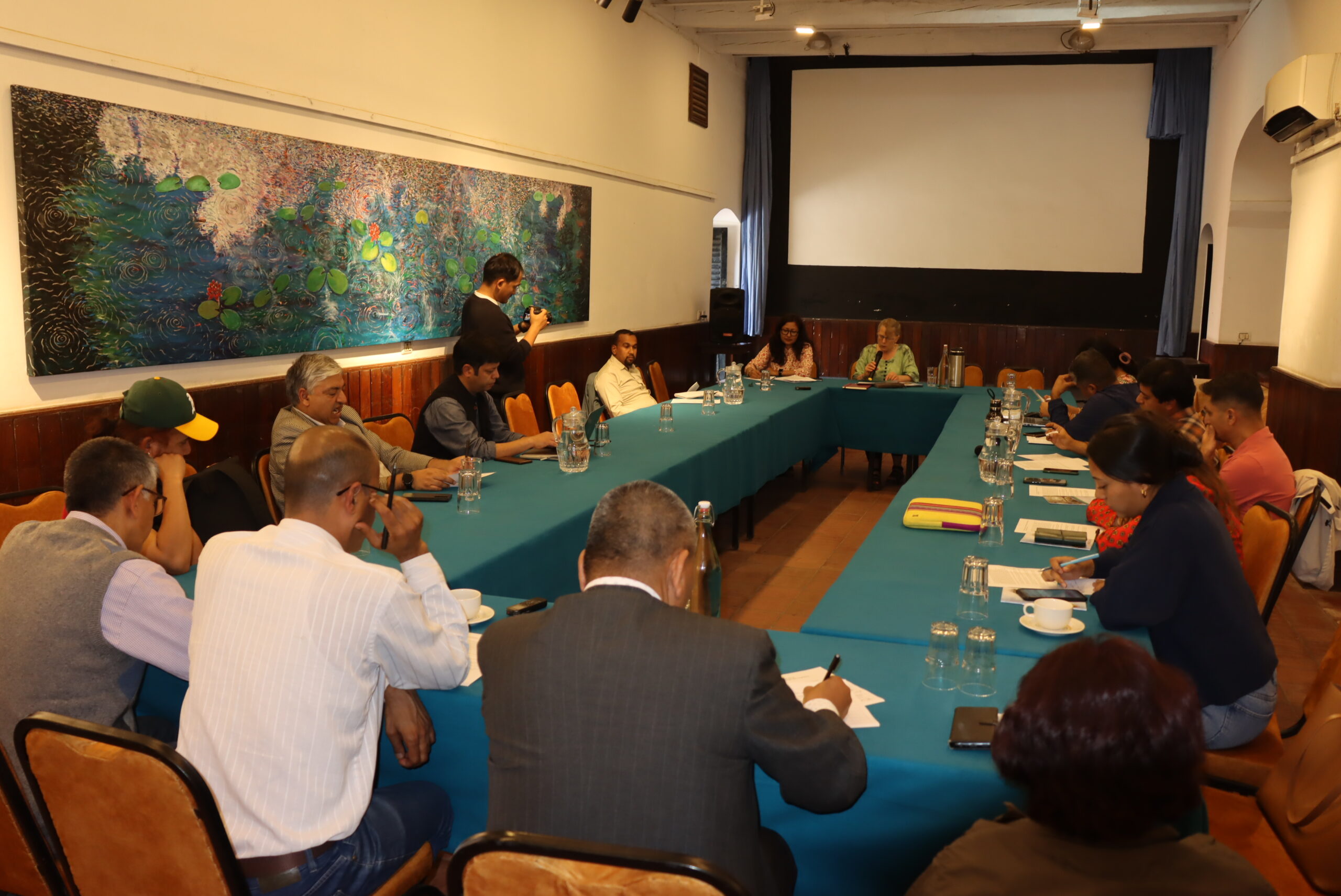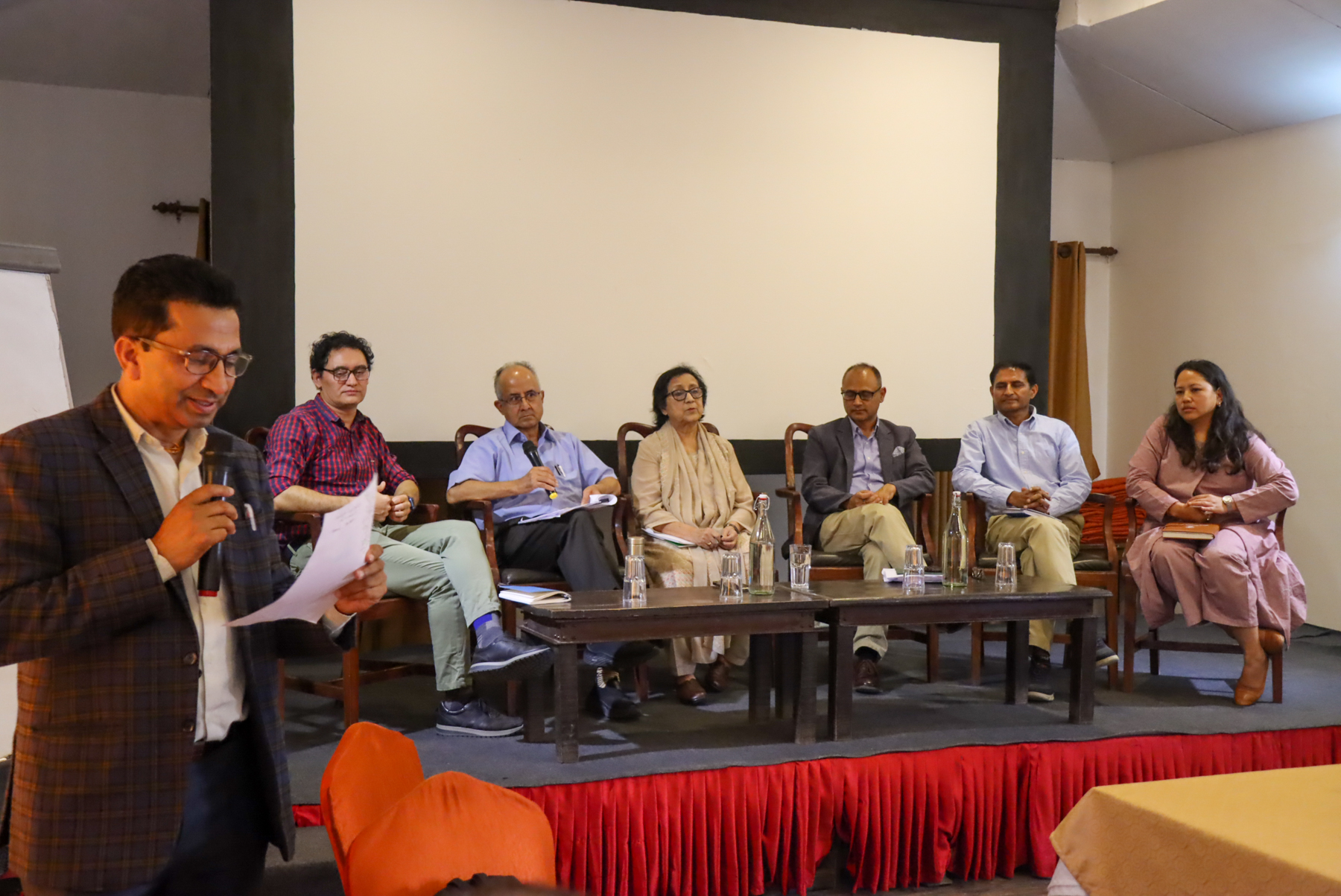Southasia Institute of Advanced Studies (SIAS) in collaboration with the University of Edinburgh (UoE), UK Research and Innovation (UKRI), and Global Challenge Research Fund (GCRF), including local partners Institute of Engineering (IoE), National Society for Earthquake Technology (NSET), Nepal Development Research Institute (NDRI) and Practical Action Nepal, organized a two-day workshop entitled “Tomorrow’s Risk Sensitive and Equitable Cities: The Future Visioning Workshop” on June 14-15, 2023. The event took place at the Rapti Rural Municipality (RRM) meeting hall, Deukhuri (Rapti) Valley, Dang.
The Future Visioning Workshop or Work Package (WP) 1 is a crucial component of the Tomorrow’s Cities Decision Support Environment (TCDSE) – a framework of a computation tool comprising physical and social sciences to analyse future multi-hazard risks. As a part of the preparatory activities prior to the deployment of the workshop in Rapti, preliminary fieldwork, community engagements, and co-production activities were carried out by SIAS’s social scientists. These field activities deployed methods like Focus Group Discussions (FGDs), interviews, transect walks, Participatory Hazard Mapping (PHM), observation and informal talks followed by field verification in the risk-prone villages, as known through PHMs, like Karangekot (Ward no. 5 of RRM), Supaila (Gadhawa Rural Municipality or GRM) and Bhulke (Ward no. 5 of RRM). Honed by the place-based knowledge through fieldwork and engagements, the workshop broadly aimed to co-produce the Community’s and Authority’s visions for a resilient and equitable capital city in the Rapti Valley over the next 30 years or so. The Valley comprises RRM, wards 1, 2 & 3 of GRM and wards 8 & 9 of Shitganga Municipality (SM).
The workshop comprised a total of 75 participants including facilitators, note-takers and technical staffs, with 46 individuals (including 18 females) representing communities and authorities (Provincial Infrastructure Development Authority or PIDA and three Municipalities i.e., RRM, GRM and SM). The participants were disaggregated into six different groups: the Tharu group, the Pahade group (the hill community or migrants), the Squatters (and informal settlers) group, the Madhesi, Muslim, and Dalit group, and the Planner (PIDA-Municipal) group. The disaggregated groups consisted of representatives from various socio-economic backgrounds, such as farmers, entrepreneurs, business persons, politicians, teachers, local stakeholders, municipality and ward representatives, government officers, representatives from local indigenous institutions, women, Dalits, and informal and marginal communities, as well as representatives of the rich households. A team of 16 facilitators and note-takers (9 females), including two local social mobilisers representing SIAS, IoE, NSET and NDRI, actively engaged in facilitating the disaggregated groups and ensuring the smooth functioning of the prescribed visioning process. Additionally, two technical personnel from SIAS were also part of the deployment of WP1 in Rapti.
The workshop commenced with short welcome remarks from the esteemed chief guest, Ms. Kamalapati Chaudhary, Vice-chairperson of RRM. Ms. Chaudhary recognized the workshop as a valuable platform for learning and encouraged all participants to actively engage in the workshop and contribute to developing a vision of Rapti capital city. Special guest of the event, Ms. Sharada Kumari Chaudhary, Vice-chairperson of GRM, in her energetic and inspiring speech, urged the participants to seize the opportunity to envision the city they desire for the future. She expressed her gratitude for being part of such an important workshop and emphasized the need for critical discussions while envisioning the city without affecting different ethnic groups living there.
Following Ms. Chaudhary’s remarks, Dr. Netra P. Timsina, former Chairperson of SIAS, shared insights from a previous visioning workshop conducted in Khokana in 2021. Dr. Timsina highlighted the necessity and significance of visioning by considering not only big infrastructures and hazards but also marginalisation and inequality issues to make an equitable and risk-free society in the future. As a final remark, echoing Dr. Timsina, Mr. Neb Bahadur Oli, Chief Administrative Officer of RRM, stressed considering both social and economic factors as well as hazards for developing an equitable city and also emphasized on the need for consistent support from the local level, provincial level, and different national and international organisations. He suggested municipal authorities to incorporate the findings from the workshop in their master plans based on the feedback from the experts. The local social mobilisers (Mr. Ramesh Nath Panthi and Mr. Aasha Ram Chaudhary) also had an opportunity to share their reflections on their experiences in forming the disaggregated groups and the challenges they faced in bringing participants to the workshop. They recognised the value of inclusive engagement and the significance of bringing diverse voices together to create a more holistic vision for the Rapti Valley.
Following the welcome remarks from the esteemed guests, Dr. Dilli P. Poudel, Senior Researcher at SIAS, briefly presented on the TC project, the geography, demography and social composition of Rapti Valley and the associated hazards based on the PHMs. Subsequently, with the presentation slides designed in Nepali language, he presented the visioning process taking examples from the Rapti fieldwork and Khokana experiences. After the technical session, the participants were divided into their designated disaggregated groups; each group facilitated by a facilitator and a note-taker. The participants actively engaged in individual and collective aspirations, designing the “wheel of assets” and formulating the visioning statements and sharing their aspirations in the panel discussion. The first day concluded with Dr. Netra Prasad Timsina providing a brief summary of the day and expressing appreciation for the participants’ enthusiasm, as well as acknowledging the facilitators and note-takers for their efforts despite the challenging working conditions at a high temperature of 40 degrees Celsius.
On the second day, the participants equally and actively engaged in co-mapping their tangible aspirations on the provided baseline maps of Rapti capital city, using tracing paper to overlay their ideas on it. They reflected intangible aspirations through aspired policies and interventions mechanism considering both scale and temporality.
Dr. Poudel concluded the workshop by thanking all the participants for their energy and active engagement in the two day’s intensive exercises. Explaining briefly other work packages, he highlighted that this is not the end of the process and that there will be more community engagement in other work packages as a part of the TCDSE. He also expressed his gratitude to the facilitators and note-keepers for their excellent facilitation and support in making the workshop successful.




